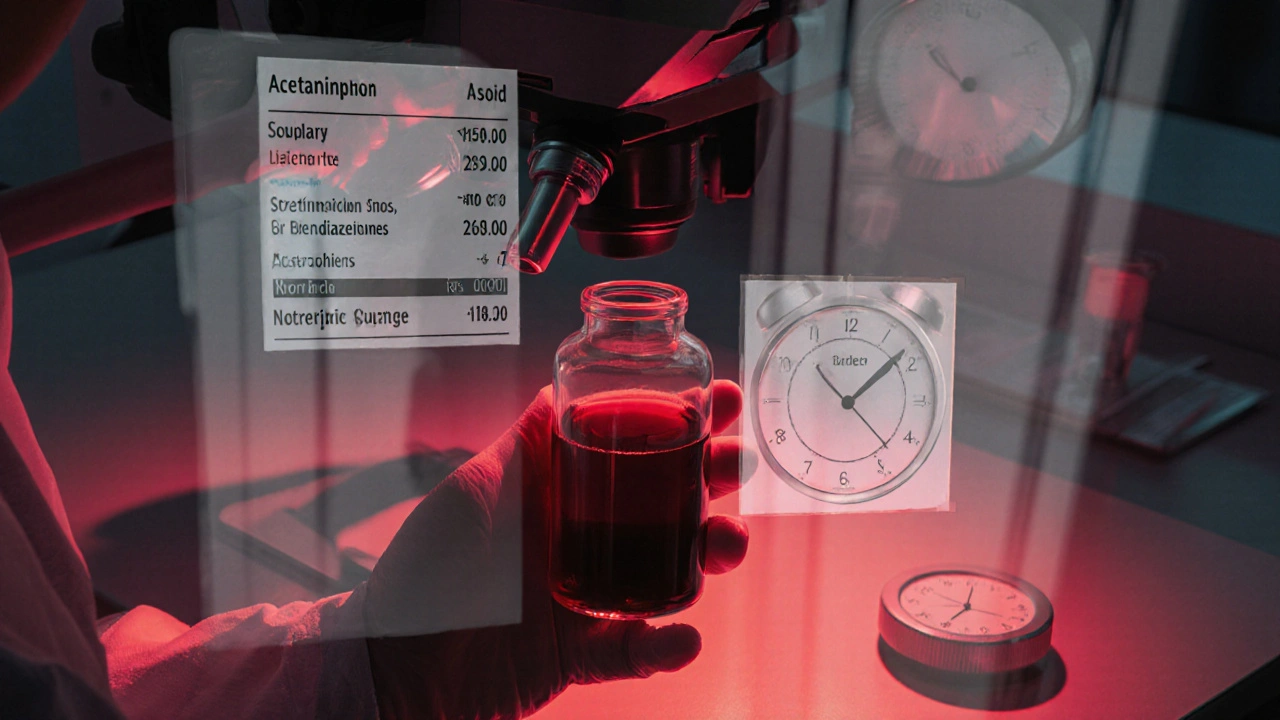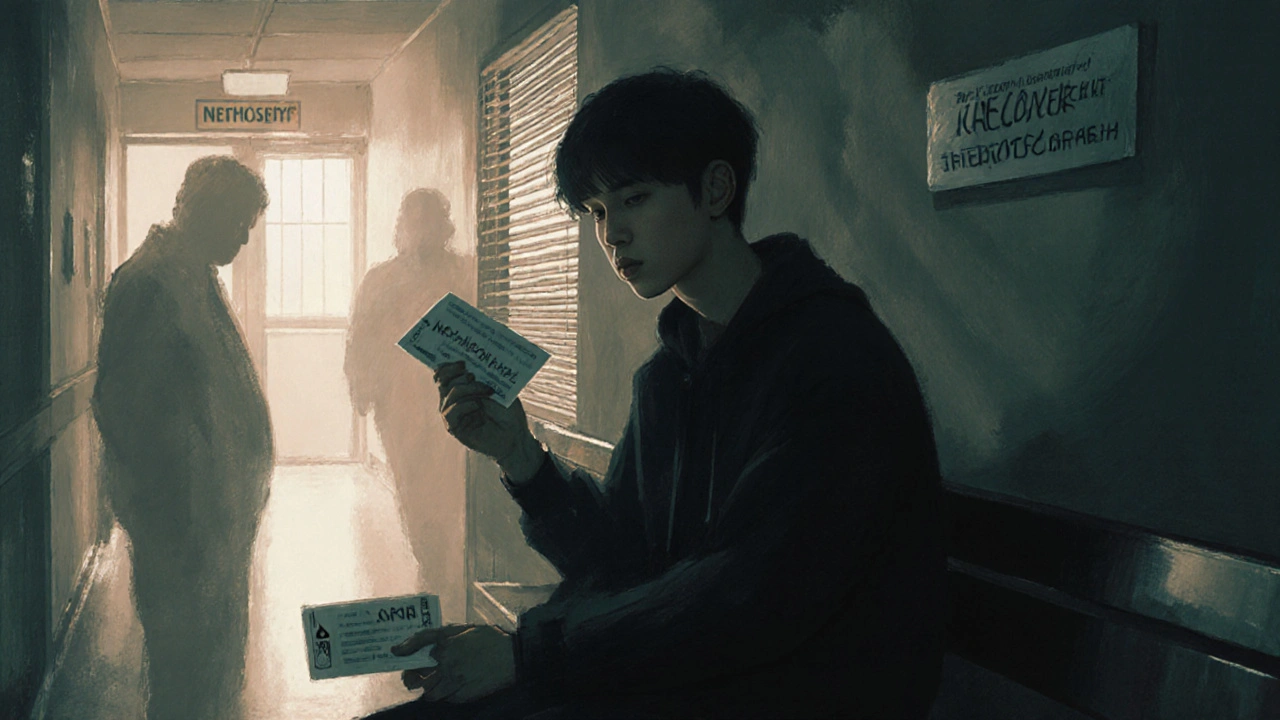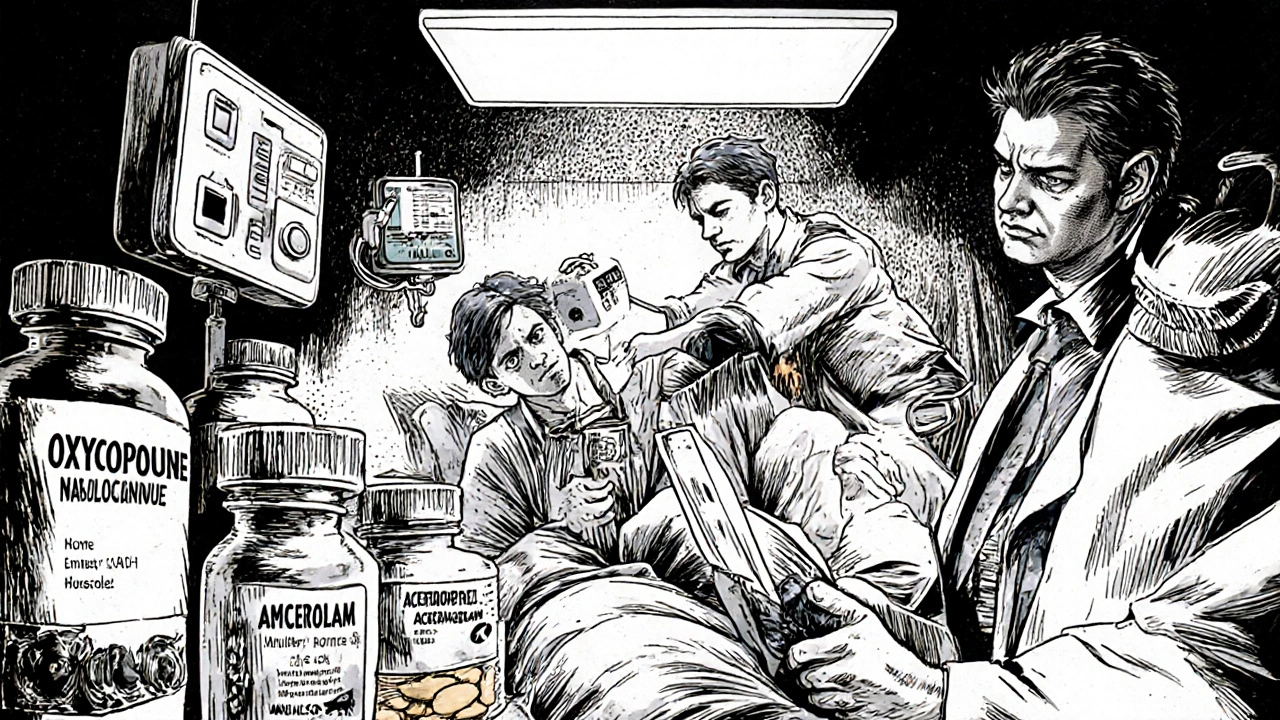When someone overdoses on just one drug, it’s serious. But when they’ve taken multiple drugs at once - say, oxycodone, acetaminophen, and alprazolam - the situation becomes a medical puzzle with life-or-death stakes. This isn’t rare. In Australia, nearly 1 in 5 overdose-related hospital admissions involve two or more substances. The mix might be prescription pills, street drugs, or even over-the-counter meds taken in excess. What works for one drug can make another worse. And if you don’t know how to untangle it, you could miss the window to save a life.
Why Multiple Drug Overdoses Are So Dangerous
It’s not just about the total amount of drugs. It’s about how they interact. Take opioids and benzodiazepines. Together, they crush your breathing faster than either one alone. A 2023 JAMA Network Open study found that overdoses involving both opioids and benzodiazepines were 3 times more likely to result in death than opioid-only overdoses. Even more surprising: acetaminophen - the active ingredient in Tylenol - can silently destroy your liver while you’re being treated for an opioid overdose. If you give naloxone and forget about the acetaminophen, the person might wake up breathing… only to crash hours later from liver failure.
And it’s not just pills. People often mix drugs with alcohol, or take meds they didn’t even know were in their system - like tramadol, which acts like an opioid but isn’t always recognized as one. Tramadol overdoses need naloxone too, but often require multiple doses or even a continuous IV drip because it lasts longer than heroin or fentanyl.
The First Responder’s Playbook: SAMHSA’s Five Steps
For anyone who might witness an overdose - a family member, friend, or bystander - there’s a clear, proven sequence. The Substance Abuse and Mental Health Services Administration (SAMHSA) outlines five steps that work every time:
- Assess the situation. Is the person unresponsive? Are their lips blue? Are they making gasping sounds? These are signs of respiratory failure.
- Call emergency services. Don’t wait. Even if you give naloxone, they still need a hospital. Paramedics carry equipment and drugs you don’t.
- Administer naloxone. If opioids are involved - even if you’re not sure - give naloxone. Use the nasal spray or injectable form. One dose. If there’s no response in 2-3 minutes, give a second dose. Fentanyl is so strong that sometimes you need three or four doses.
- Support breathing. While waiting for naloxone to kick in, start rescue breathing. Tilt the head back, pinch the nose, give one breath every 5 seconds. This alone can keep someone alive until help arrives.
- Monitor closely. Naloxone wears off in 30-90 minutes. Opioids can stay in the system for hours. If the person wakes up and then slips back into unconsciousness, give another dose of naloxone and keep breathing for them until EMS gets there.
Don’t assume recovery means safety. A person who seems fine after naloxone can still die hours later from delayed liver failure, heart rhythm problems, or respiratory depression returning. They need to go to the hospital - no exceptions.
What Hospitals Do When Multiple Drugs Are Involved
Hospitals don’t just treat one thing at a time. They run a full toxicology screen - blood tests for acetaminophen, salicylates, benzodiazepines, opioids, and more. They check liver enzymes, kidney function, and acid levels. Then they act on multiple fronts at once.
For acetaminophen overdose: The key is acetylcysteine. It’s the antidote. But timing matters. If the person took the drug within the last 4 hours, activated charcoal might be given to stop more from being absorbed. After that, it’s all about acetylcysteine. The dose isn’t based on actual weight if someone weighs over 100 kg - it’s capped at 100 kg to avoid side effects. For massive overdoses - acetaminophen levels above 900 μg/mL with confusion or acidosis - they’ll start hemodialysis. And they keep giving acetylcysteine during dialysis at 12.5 mg/kg/hour.
For benzodiazepines: Flumazenil can reverse them. But it’s risky. If the person is dependent on benzodiazepines - maybe they’ve been taking them for years - flumazenil can trigger violent seizures. Doctors avoid it unless the overdose is life-threatening and they’re sure the person isn’t dependent.
For opioids: Naloxone is still the go-to. But they monitor for hours. They watch for returning respiratory depression. They check for other drugs that might be lingering. And they don’t stop until they’re sure everything is cleared.

The Hidden Risk: Repeated Supratherapeutic Ingestion
Not all overdoses are one-time events. Some people take a little extra acetaminophen every day for pain - maybe 2 tablets instead of 1. Over 24-48 hours, that adds up. This is called repeated supratherapeutic ingestion. It’s sneaky. No one realizes they’ve overdosed until their liver enzymes spike and they’re vomiting blood.
The 2023 JAMA guidelines say: if someone has taken too much acetaminophen over more than 24 hours, and their blood level is above 20 μg/mL - or their AST/ALT liver enzymes are elevated - they need acetylcysteine immediately. No waiting. No nomogram checks. Just treat.
And here’s the catch: if they’re also taking opioids, they might not even look like they’re overdosing. No pinpoint pupils. No slow breathing. Just vague nausea, fatigue, or confusion. That’s why doctors now ask: “Have you been taking more painkillers than usual?” - not just “Did you take too many pills?”
What You Need to Know About Activated Charcoal
Activated charcoal binds to drugs in the gut and stops them from entering the bloodstream. But it’s not magic. It only works if given within 1-2 hours of ingestion, and even then, not for all drugs. It doesn’t work well on opioids or alcohol.
And it’s messy. People vomit it. It stains everything. And it can interfere with other medications - including birth control pills. If someone takes charcoal and is on oral contraceptives, they need backup contraception for the next 7 days. Hospitals always warn about this.
Don’t try to give it yourself. Emergency teams have the right type, the right dose, and the right timing. Don’t risk making things worse.

Long-Term Recovery Starts After the Emergency
Surviving a multiple drug overdose isn’t the end. It’s the beginning of a longer road. The World Health Organization says people released from prison are at the highest risk of dying from overdose in the first four weeks. Why? Their tolerance drops. They go back to using the same dose they used before incarceration - and it kills them.
That’s why follow-up care is non-negotiable. After the hospital, patients need:
- A primary care checkup to assess liver and kidney damage
- A mental health screening for depression, anxiety, or trauma
- Referral to substance use treatment - methadone, buprenorphine, or counseling
- Education on naloxone use for themselves and their support network
Studies show that when overdose survivors get connected to long-term care, their chance of dying from another overdose drops by over 60%. That’s not just a statistic. That’s someone going home to their kids, their job, their life.
What’s Changing in Overdose Management
Things are improving. Naloxone is now available over the counter in many places, including parts of Australia. Community programs hand out free kits with training videos. Pharmacies train staff to explain how to use them. Schools teach teens what to do if a friend overdoses.
And the guidelines are getting smarter. The old “massive ingestion” label is gone. Now it’s about risk - based on timing, dose, and other drugs involved. The Rumack-Matthew nomogram was updated in 2023 to reflect real-world cases. Doctors now know that fentanyl overdoses need more naloxone, and that tramadol requires longer monitoring.
The biggest shift? Treating overdose not as a moral failure, but as a medical emergency - one that requires both immediate action and long-term support.
Can you overdose on just one pill of a combination drug like Vicodin?
Yes. Vicodin contains both hydrocodone (an opioid) and acetaminophen. Taking just 6-8 pills at once can be deadly - the acetaminophen can cause liver failure, while the opioid can stop your breathing. Even if you feel fine at first, liver damage can develop hours later. Never assume a prescription pill is safe in large amounts.
Is naloxone safe to give if you’re not sure opioids are involved?
Yes. Naloxone only works on opioids. If there are no opioids in the system, it has no effect - and no harmful side effects. Giving it won’t hurt someone. Not giving it when opioids are present can kill them. Always err on the side of giving naloxone if someone is unresponsive and breathing poorly.
Why can’t you just use flumazenil for benzodiazepine overdoses?
Flumazenil reverses benzodiazepines, but it can trigger seizures in people who are physically dependent on them - which many long-term users are. In a mixed overdose with opioids, using flumazenil could cause a seizure while the person is still under opioid sedation. That’s why doctors avoid it unless the situation is life-threatening and they’re certain there’s no dependence.
Does activated charcoal work for alcohol overdoses?
No. Activated charcoal doesn’t bind to alcohol effectively. It’s only useful for certain drugs like acetaminophen, aspirin, or some antidepressants - and only if given within an hour of ingestion. For alcohol overdose, treatment is supportive: IV fluids, monitoring breathing, and waiting for the body to metabolize it.
What should you do if someone wakes up after naloxone but seems confused?
Keep them awake and calm. Confusion after naloxone can mean the opioids are still in their system, or they’re experiencing withdrawal. Don’t let them go to sleep. Call emergency services immediately. Even if they seem okay, they need to be monitored for at least 4-6 hours in a hospital because respiratory depression can return.
Can you use naloxone on a child who overdosed?
Yes. Naloxone is safe for children and is dosed by weight. In fact, accidental opioid exposure in children - from pills left in reach - is a growing concern. If a child is unresponsive and breathing shallowly, give naloxone and call for help immediately. The same five-step protocol applies.
How long should you monitor someone after a multiple drug overdose?
At least 6-12 hours in a hospital setting. For acetaminophen, liver damage can peak at 72 hours. For opioids, naloxone wears off before the drug does. For benzodiazepines, sedation can linger. Monitoring includes repeated blood tests, vital signs, and neurological checks. Discharge too early, and you risk a fatal delay.
Is it possible to recover fully after a multiple drug overdose?
Yes - if treatment is fast and complete. Many people go on to live full lives after an overdose, especially if they get connected to ongoing care. Liver damage from acetaminophen can heal if caught early. Lung function returns after opioid reversal. The key is not just surviving the emergency, but getting help for the underlying causes - addiction, pain, mental health - so it doesn’t happen again.
What Comes Next After the Emergency
Surviving a multiple drug overdose is just the first step. The real work begins after the hospital. That’s when people need access to counseling, medication-assisted treatment, and community support. Programs that combine naloxone distribution with recovery services have cut overdose deaths by up to 50% in some areas.
If you’ve ever been near someone who overdosed - or if you’re worried about your own or a loved one’s medication use - don’t wait for a crisis. Learn how to use naloxone. Know the signs of overdose. Talk to a doctor about safe prescribing. And remember: helping someone through an overdose isn’t enabling. It’s saving a life - and giving them a chance to get the help they need.


Leisha Haynes
November 23, 2025 AT 01:01So basically if you mix pills like it’s a smoothie you’re playing russian roulette with your liver and lungs
and somehow people still think OTC meds are harmless
my aunt took extra tylenol for her back pain for a week and ended up in ICU
no one saw it coming because she wasn’t ‘doing drugs’
just being smart about pain
yeah right
Andrew McAfee
November 24, 2025 AT 18:19in india we dont have naloxone in every pharmacy but we do have paracetamol in every corner shop
and people take 4 at a time for headaches
no one tells them its a silent killer
the system is broken when prevention is cheaper than treatment but no one funds it
Shirou Spade
November 25, 2025 AT 19:25the tragedy isnt the overdose its the assumption that human suffering can be solved with a pill
we treat pain like a bug to be eradicated not a signal to be understood
when we stop seeing addiction as a moral failing and start seeing it as a cry for connection
then maybe we stop treating symptoms and start healing roots
naloxone saves lives but it doesnt fix the loneliness that made the pills necessary in the first place
Lisa Odence
November 27, 2025 AT 01:50It is absolutely CRITICAL to understand that activated charcoal is NOT a universal antidote and its administration requires precise timing and clinical judgment - otherwise you risk aspiration pneumonia, electrolyte imbalances, and interference with essential medications such as oral contraceptives, which necessitates backup contraception for a full 7-day period post-administration - and yet, laypersons still try to DIY this in garage kitchens with grocery store charcoal powder 😭💀
Patricia McElhinney
November 28, 2025 AT 18:57People who mix drugs are just lazy, selfish, and uneducated. If you can't follow a simple prescription label you don't deserve to live. Naloxone isn't a free pass to keep doing dumb shit. Hospitals should charge them $10k for every rescue. No insurance. No exceptions. And stop giving out free kits like they're candy. This isn't a public service, it's enabling. 🤦♀️
Agastya Shukla
November 29, 2025 AT 11:10From a pharmacokinetic perspective, the pharmacodynamic interactions between CYP450-metabolized substrates like tramadol and benzodiazepines create non-linear respiratory depression curves, especially when combined with acetaminophen-induced hepatic enzyme suppression - which in turn alters naloxone clearance kinetics. The clinical implication is that standard dosing protocols may be insufficient in polypharmacy cases, necessitating extended monitoring windows and titratable IV infusions rather than bolus-only approaches.
Dolapo Eniola
November 29, 2025 AT 13:49USA thinks it can fix everything with a spray and a pamphlet
in Nigeria we don't have naloxone but we have family
we don't wait for EMS we carry them to the clinic ourselves
you think your system is advanced? we don't need your fancy guidelines to know when someone is dying
stop treating overdose like a science experiment and start treating it like a human crisis 🙏
Amy Hutchinson
November 30, 2025 AT 06:53